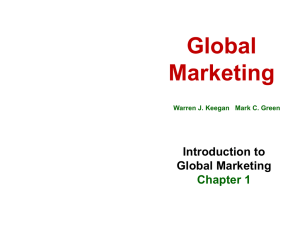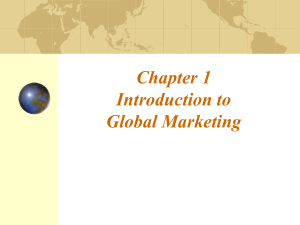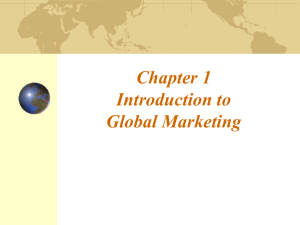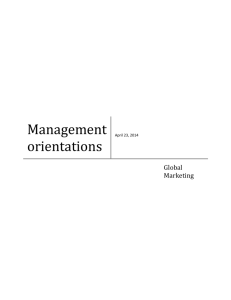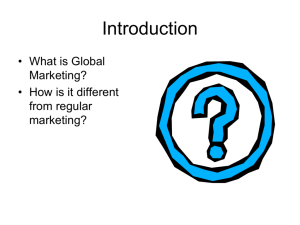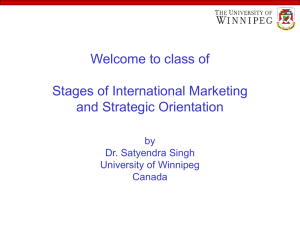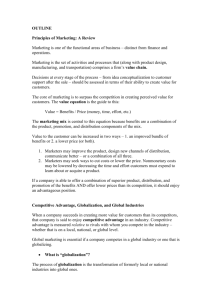Chapter 1 - Marketing Club UMT
advertisement
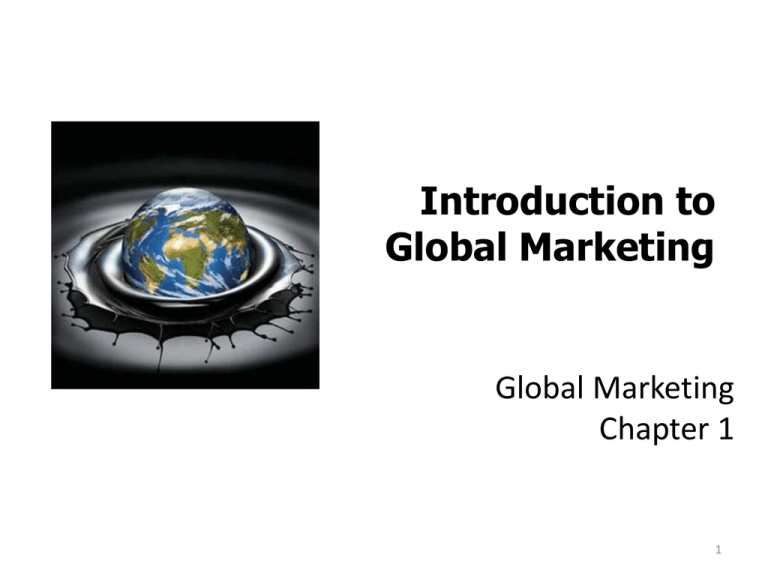
Introduction to Global Marketing Global Marketing Chapter 1 1 Contents • • • • • Introduction and overview Principles of marketing The importance of global marketing Global marketing strategies Management orientations; ethnocentric, polycentric, regiocentric and geocentric Introduction • Global vs. “Regular” Marketing – Scope of activities are outside the home-country market 1-3 Global Marketing • Create value for customers by improving benefits or reducing price – Improve the product – Find new distribution channels – Create better communications – Cut monetary and non-monetary costs and prices Value=Benefits/Price 1-4 Globalization “Globalization is the inexorable integration of markets, nation-states and technologies to a degree never witnessed before—in a way that is enabling individuals, corporations and nationstates to reach around the world farther, faster, deeper and cheaper than every before, and in a way that is enabling the world to reach into individuals, corporations and nation-states farther, faster, deeper and cheaper than ever before.” Thomas Friedman 1-5 Global Industries • An industry is global to the extent that a company’s industry position in one country is interdependent with its industry position in another country • Indicators of globalization: – Ratio of cross-border trade to total worldwide production – Ratio of cross-border investment to total capital investment – Proportion of industry revenue generated by companies that compete in key world regions 1-6 Competitive Advantage, Globalization, and Global Industries • Focus – Concentration and attention on core business and competence “Nestle is focused: We are food and beverages. We are not running bicycle shops. Even in food we are not in all fields. There are certain areas we do not touch…We have no soft drinks because I have said we will either buy Coca-Cola or we leave it alone. This is focus.” Helmut Maucher, former chairman of Nestlé SA 1-7 Global Marketing: What It Is and What It Isn’t Single Country Marketing Strategy Global Marketing Strategy • Global Market Participation • Marketing Mix Development • Target Market Strategy • Marketing Mix – – – – – 4 P’s: Adapt or Standardize? • Concentration of Marketing Activities • Coordination of Marketing Activities • Integration of Competitive Moves Product Price Promotion Place 1-8 Standardization versus Adaptation • Globalization (Standardization) – Developing standardized products marketed worldwide with a standardized marketing mix – Essence of mass marketing • Global localization (Adaptation) – Mixing standardization and customization in a way that minimizes costs while maximizing satisfaction – Essence of segmentation – Think globally, act locally 1-9 Standardization versus Adaptation Arabic Read right to left Chinese “delicious/happiness” 1-10 The Faces of Coca-Cola Around the World McDonald’s Global Marketing Marketing Mix Element Standardization Product Big Mac Localized Spicy Fried Chicken (Malaysia) Promotion Brand name Malaysian models Advertising Slogan “I’m Loving It” Place Price Free-standing Free-standing and drive-thru Big Mac is $3.10 in U.S. $1.31(China), RM7.00 1-11 The Importance of Going Global • For U.S. companies, 75% of total world market for goods and services is outside the country – Coca-Cola earns 75% of operating income and 2/3 of profit outside of North America • For Japanese companies, 85% of world market is outside the country • 94% of market potential is outside of Germany for its companies 1-12 The Fortune Global 500 1-13 Consumer/Industrial Markets Product/Service Market Size (Billions) Cigarettes Luxury Goods Cosmetics Personal Computers Bottled Water Container Shipping Construction Equip. Crop Seeds CRM Services $295 230 200 175 100 150 90 30 6 1-14 Management Orientations • Ethnocentric Orientation – Home country is superior to others – Sees only similarities in other countries – Assumes products and practices that succeed at home will be successful everywhere – Leads to a standardized or extension approach 1-15 Management Orientations • Polycentric Orientation – Each country is unique – Each subsidiary develops its own unique business and marketing strategies – Often referred to as multinational – Leads to a localized or adaptation approach that assumes products must be adapted to local market conditions 1-16 Management Orientations • Regiocentric Orientation – A region is the relevant geographic unit • Ex: The NAFTA or European Union market – Some companies serve markets throughout the world but on a regional basis • Ex: General Motors had four regions for decades 1-17 European Union Management Orientations • Geocentric Orientation – – – – – Entire world is a potential market Strives for integrated global strategies Also known as a global or transnational company Retains an association with the headquarters country Pursues serving world markets from a single country or sources globally to focus on select country markets – Leads to a combination of extension and adaptation elements 1-18 Driving Forces Affecting Global Integration and Global Marketing • Multilateral trade agreements • Converging market needs and wants and the information revolution • Transportation and communication improvements • Product development costs 1-19 Driving Forces Affecting Global Integration and Global Marketing • Quality – R&D as a percent of sales • World economic trends – 2008 global crisis – Growing middle class in China, India, Brazil, etc. – Rapid growth in China pre2008 – Movement to free markets worldwide 1-20 Driving Forces Affecting Global Integration and Global Marketing • Leverage – Experience transfers – Scale economies – Resource utilization – Global strategy 1-21 Restraining Forces Affecting Global Integration and Global Marketing • • • • Management myopia Organizational culture National controls Opposition to globalization 1-22 Discussion questions • How do the global marketing strategies of Perodua and Honda differ? • Describe the differences between the four management orientations (ethnocentric, polycentric, regiocentric and geocentric). Looking Ahead to Chapter 2 The Global Economic Environment 1-24
